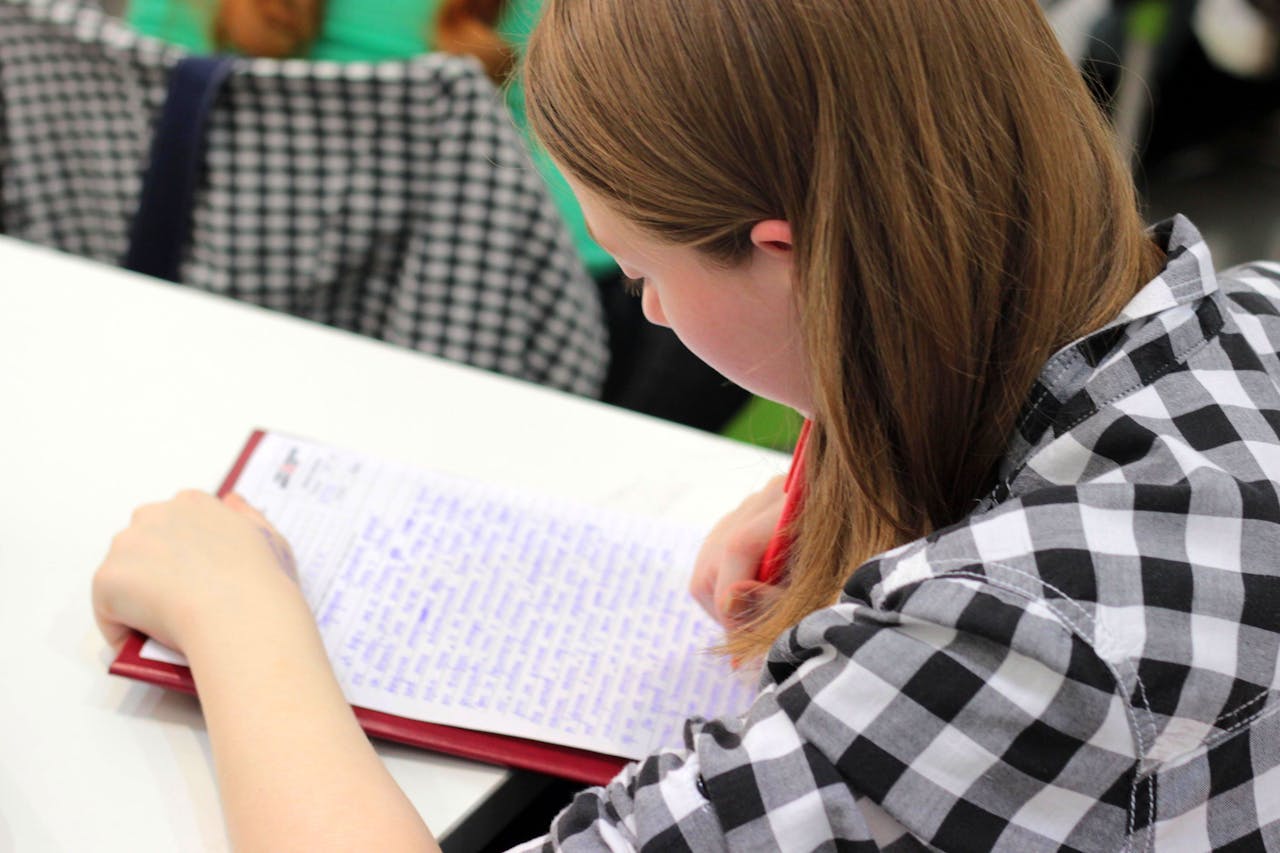How to Easily and Quickly Delete Reposts on TikTok, Know the Tips
Sometimes we may want to delete those reposts for various reasons. In this article, we will discuss in depth how to easily and quickly delete reposts on TikTok.

Kapanlagi.com - Connective words or conjunctions are an important part of the structure of sentences in the Indonesian language. Here are 350 examples of connective words along with their usage in sentences:

writing in a book (credit: pexels.com)
Additive conjunctions function to connect equivalent elements:
1. And – Mother is cooking and father is reading the newspaper.
2. As well as – Father, mother as well as brother will go to Bandung next week.
3. Also – He is good at singing and also talented at dancing.
4. Again – The younger sibling asks to be bought ice cream again.
5. Moreover – Moreover, we are already late to go now.
6. In addition – In addition, we also need to buy groceries.
7. Besides that – Besides that, we must consider transportation costs.
8. Additionally – Additionally, the weather today is very bright.
9. Not only... but also – He is not only smart, but also diligent.
10. Not only... but rather also – Not only beautiful, but also intelligent.
Conjunctions of contrast connect two opposing things:
11. But – The house is big but not well-maintained.
12. However – He has tried hard, however, he still failed.
13. While – The younger sibling likes ice cream while the older sibling prefers chocolate.
14. Rather – He is not a doctor but rather a nurse.
15. On the contrary – Don't get angry, on the contrary, try to forgive.
16. Nevertheless – I want to go, nevertheless, it is raining heavily.
17. Even so – Even so, we must remain optimistic.
18. Although – Although, he still smiles.
19. Even though – Even though it is difficult, we must try.
20. Although – Although tired, he still works hard.
Conjunctions of choice express a choice between two or more things:
21. Or – Do you want to buy shoes or a bag?
22. Either – Fried rice or fried noodles, both are fine, he likes them both.
23. Whether – Whether morning, afternoon, or night, he just lazes around.
24. Both… and – Both children and adults like ice cream.
25. Whether… or – Whether he comes or not, we still have to be ready.
26. Whether… or – Do you want to go now or later?
27. Either… or – It might rain or it might be sunny, we still have to leave.
28. Can… or – You can come or not, it's up to you.
29. Want… or – Whether you like it or not, you have to accept it.
30. Let… or – Whether it is difficult or easy, we will face it together.
Time connectives indicate the temporal relationship between two events:
31. After – After eating, he went straight to sleep.
32. Before – Wash your hands before eating.
33. When – When it rained, we were on the road.
34. At that time – At that time, we were studying.
35. During – During the holidays, we stayed at grandmother's house.
36. Since – Since childhood, he has liked reading.
37. Until – We studied until late at night.
38. Until – He waited until sunset.
39. While – While mother was cooking, father read the newspaper.
40. As – He smiled while waving.

writing in a book (credit: pexels.com)
Purpose connectives express the intent or purpose of an action:
41. So that – He studies hard so that he passes the exam.
42. In order to – They clean the river in order to prevent flooding again.
43. For – Mother makes breakfast for the children.
44. For the sake of – He is willing to sacrifice for the sake of his family.
45. In order to – They hold meetings in order to discuss this issue.
46. So that – Go to bed early so that you won't be late tomorrow.
47. In order to – He saves diligently in order to buy a house.
48. So that – He exercises so that he stays healthy.
49. For the sake of – For the sake of the future, we must work hard.
To – He works hard to finance his younger sibling's education.
Causal connectives explain the reasons for an event occurring:
51. Because – He did not go to school because he was sick.
52. Cause – The road is congested because there was an accident.
53. Due to – Due to the rain, the event was canceled.
54. Because of – Because of waking up late, he missed the bus.
55. Due to the fact that – Due to the bad weather, the flight was delayed.
56. Because of – Because of his carelessness, the project failed.
57. Thanks to – Thanks to his hard work, he passed the exam.
58. As a result of – As a result of his negligence, a fire occurred.
59. Due to – Due to heavy rain, many roads were flooded.
60. Caused by – Caused by strong winds, many trees fell.
Conjunctions of consequence indicate the result or consequence of an action:
61. So – He studied hard so he graduated with the best grades.
62. Therefore – The rain fell heavily, therefore the road became flooded.
63. As a result – He often stayed up late, as a result his health declined.
64. Consequently – He broke the rules, consequently he was punished.
65. As a result – He practiced diligently, as a result he became the champion.
66. Thus – Thus, this problem is resolved.
67. Therefore – Therefore, we must be more careful.
68. So – So, we must make a decision soon.
69. Therefore – Therefore, we need to think it over carefully.
70. For that reason – For that reason, we must change our strategy.
Conditional conjunctions state the conditions that must be met:
71. If – If it rains, we will cancel the picnic.
72. If – If you study hard, you will definitely succeed.
73. When – When the weather is good, we will go fishing.
74. If – If there is time, stop by the house.
75. As long as – You may go as long as you have completed your tasks.
76. On the condition that – On the condition that you promise to study diligently.
77. Suppose – Suppose I had wings, I would fly.
78. If only – If only he came, it would surely be enjoyable.
79. Suppose that – Suppose it does not rain, the harvest will surely fail.
80. Whenever – Whenever the situation allows, we will carry it out.

reading a book (credit: pexels.com)
Unconditional conjunctions indicate that something happens without conditions:
81. Although – Although it rains, he still goes.
82. Even though – Even though tired, he still smiles.
83. Even if – Even if it's difficult, he does not give up.
84. Even though – Even though it's expensive, he still buys it.
85. Although – Although it's forbidden, he still dares.
86. Even though – Even though so, we must remain optimistic.
87. No matter how – No matter how difficult, we must try.
88. Regardless of – Regardless of the situation, we must be patient.
89. Even so – Even so, we must not lose hope.
90. However – However, we must keep trying.
Comparative conjunctions are used to compare two things:
91. Like – Her face is beautiful like a fairy.
92. As if – He runs as if he were lightning.
93. Like – Her eyes shine like stars.
94. As – She walks as a peacock.
95. Like – His life is like a wheel that turns.
96. Like – Like water and oil, they never get along.
97. As if – He speaks as if he knows everything.
98. As though – He acts as though nothing happened.
99. Like – Her beauty is like a full moon.
100. Similar – Their faces are similar to a split areca nut.
Emphasizing conjunctions serve to provide emphasis:
101. Even – He is very smart, even becoming the class champion.
102. Moreover – He is not angry, moreover, he smiles.
103. Let alone – He does not like vegetables, let alone fruits.
104. Besides – Besides, we have already made a promise.
105. Additionally – Additionally, the price is very high.
106. Furthermore – Furthermore, we are already late.
107. Moreover – Moreover, he is very talented.
108. Furthermore – Furthermore, he is very diligent.
109. Especially – Especially, we must take care of our health.
110. Particularly – Particularly, we need to pay attention to children.
Sequential connectives indicate the order of events or processes:
111. First – First, we must make a plan.
112. Second – Second, we need to prepare the materials.
113. Third – Third, we start working on the project.
114. Next – Next, we will discuss the results of the work.
115. Then – Then, we will evaluate the results.
116. Finally – Finally, we can complete this task.
117. Initially – Initially, we need to collect data.
118. Then – Then, we will analyze the data.
119. Next – Next, we will create a report.
120. Lastly – Lastly, we will present the results of the work.

writing in a book (credit: pexels.com)
Explanatory connectives provide additional explanations:
121. That is – There are two types of fruit, that is apples and oranges.
122. Namely – He has two hobbies, namely reading and writing.
123. That – He said that he will come tomorrow.
124. Is – Our main goal is to help the community.
125. Is – What is meant by photosynthesis is the process of making food in plants.
Is – Education is the key to the progress of the nation.
127. Including – There are many fruits here, including mangoes and rambutans.
128. Consists of – This committee consists of five members.
129. Covers – His duties cover sweeping, mopping, and tidying up the room.
130. Includes – This research includes various aspects of community life.
Conjunctions of limitation provide restrictions or exceptions:
131. Except – All students passed, except Andi.
132. Besides – Besides reading, he also likes to write.
133. Only – Only he knows the truth.
134. Rather – It was not him but his brother who did it.
135. Except for – Everyone can participate, except those who have not paid the dues.
136. Just – Just you can help me.
137. Only – You only can go, I will wait here.
138. Just to – I am just reminding you, not commanding.
139. Solely – This is solely for your own good.
140. Nothing but – My goal is nothing but to help you.
Connective words for justification are used to justify a statement:
141. Indeed – Indeed, what you said is true.
142. In fact – In fact, he is a good person.
143. Actually – Actually, I did not intend to hurt you.
144. In reality – In reality, he is indeed guilty.
145. The fact is – The fact is, global warming is indeed happening.
146. Essentially – Essentially, we are all brothers.
147. Essentially – Essentially, we all want to be happy.
148. The reality is – The reality is, it is not that easy to solve this problem.
149. The fact is – The fact is, he is indeed talented in this field.
150. In essence – In essence, we really need to cooperate.
Connective words for conclusion are used to draw conclusions:
151. So – So, we must take action immediately.
152. Therefore – Therefore, we need to think of other solutions.
153. Thus – Thus, this issue is resolved.
154. For that reason – For that reason, we must be more careful.
155. In conclusion – In conclusion, we need to change our strategy.
156. In summary – In summary, we must work harder.
157. In short – In short, we must save on expenses.
158. Briefly – Briefly, we must be more disciplined.
159. Finally – Finally, we succeeded in completing this project.
160. The conclusion is – The conclusion is, we need to conduct further research.

reading a book on a tablet (credit: pexels.com)
Connecting words for explanation provide additional information:
161. That is to say – That is to say, we must be more meticulous in our work.
162. In other words – In other words, we need to change our plans.
163. In other terms – In other terms, we must conserve energy.
164. Clearly – Clearly, we need more help from more people.
165. To be clear – To be clear, we must not give up.
166. In short – In short, we need to work together.
167. To sum up – To sum up, we need to think creatively.
168. In brief – In brief, we must take risks.
169. Specifically – Specifically, we need to create a more organized schedule.
170. Essentially – Essentially, we must focus on the main goal.
Conditional connectives express situations that have not or do not occur:
171. If only – If only I were rich, I would help many people.
172. Suppose – Suppose I could fly, I would travel around the world.
173. For example – For example, if I became president, I would eradicate corruption.
174. If it were the case that – If it were the case that it doesn't rain, the harvest would surely fail.
175. If – If he comes, it will surely be pleasant.
176. If only – If only I studied harder, my grades would surely be better.
177. If only – If only I had more time, I would learn a foreign language.
178. If only – If only I were braver, I would enter that competition.
179. Suppose – Suppose we win the lottery, what will we do?
180. Imagine – Imagine if we could live forever, what would we do?
Linking words for details are used to elaborate or specify:
181. Among others – Her hobbies include reading, writing, and drawing.
182. Such as – Tropical fruits such as mangoes, rambutans, and durians.
183. For example – There are many ways to save energy, for example, turning off lights when not in use.
184. For instance – Many countries are developing rapidly, for instance, Singapore and South Korea.
185. Including – Many types of water sports, including swimming and surfing.
186. Among them – There are several contributing factors, among them a lack of education and poverty.
187. As an example – As an example, we can use solar energy to save electricity.
188. For instance – For instance, we can plant vegetables in the yard.
189. Such as – Such as, we can use bicycles for short distances.
190. Call it – Many artists have entered the political arena, call it Prabowo and Sandiaga Uno.
Conjunctions of emphasis are used to strengthen statements:
191. Even – He is very smart, even becoming the overall champion.
192. Instead – Instead of being sad, he is laughing.
193. On the contrary – It is precisely in difficulties that we can find strength.
194. Moreover – He does not like math, moreover physics.
195. Especially – Everyone likes him, especially his family.
196. Furthermore – All food is delicious, furthermore his mother's cooking.
197. Besides – Besides, we have already made a promise.
198. Additionally – Additionally, the price is very affordable.
199. Especially – We must maintain our health, especially during this pandemic.
200. Particularly – Everyone must be vigilant, particularly the elderly and children.

writing in a book (credit: pexels.com)
The conjunctions indicating time show the sequence or period of time:
201. When – When it rains, we are on the road.
202. At that time – At that time, we were studying.
203. While – While I was young, I often played by the river.
204. As – As the sun sets, the view becomes very beautiful.
205. While in school – While in school, he was always the class champion.
206. As long as – As long as we are young, we must learn a lot.
207. While – While mother is cooking, father reads the newspaper.
208. While – He smiled while waving.
209. While – He talked while smiling.
210. While – While waiting for the bus, he read a book.
The conjunctions indicating place show location or direction:
211. Where – The house where I was raised has been sold.
212. Wherever – Wherever you go, I will follow you.
213. From where – From where did you get that information?
214. Place – This is the place we usually played.
215. Location – The campsite is located at the foot of the mountain.
216. Area – This area is famous for its natural beauty.
217. Region – This region is rich in natural resources.
218. Area – This area is closed to the public.
219. Zone – This zone is protected by the government.
220. Zone – This zone is prone to earthquakes.
Connecting words indicating manner show how something is done:
221. With – He completed his task quickly.
222. Peacefully – This issue must be resolved peacefully.
223. Through – We can learn many things through experience.
224. Via – Information is spread via social media.
225. Using – He writes using a pen.
226. Wearing – She went to the party wearing a red dress.
227. Based on – The decision was made based on the voting results.
228. According to – According to me, that idea is very good.
229. In accordance with – This action is in accordance with the applicable regulations.
230. Based on – Our country is based on Pancasila.
Connecting words indicating means show the tools used:
231. With – He cut the cake with a knife.
232. Using – The farmer cultivates the field using a tractor.
233. Wearing – He writes using a pencil.
234. Utilizing – We can utilize solar energy for electricity.
235. Through – Messages are conveyed through email.
236. Via – Transactions are conducted via online applications.
237. Thanks to – Thanks to modern technology, communication has become easier.
238. With the help of – With the help of a microscope, we can see cells.
239. Using services – Goods delivery uses courier services.
240. Through the medium of – Through the medium of the internet, information spreads quickly.

writing in a book (credit: pexels.com)
Conjunctions indicating comparison are used to compare:
241. Rather than – Better late than never.
242. Compared to – The price of houses this year is more expensive compared to last year.
243. Instead of – He prefers tea instead of coffee.
244. Rather than – Rather than getting angry, he just smiled.
245. Comparable – His salary is not comparable to his workload.
246. Balanced – Rights and obligations must be balanced.
247. Equivalent – His position is equivalent to that of a manager.
248. Proportional – His effort is proportional to the results obtained.
249. As – As we know, life is full of challenges.
250. In accordance with – The results obtained are in accordance with his hard work.
Connector words indicating degree show the extent or level:
251. Most – He is the smartest student in his class.
252. Very – The weather today is very hot.
253. Extremely – The exam questions were extremely difficult.
254. Too – The price of that item is too expensive.
255. Quite – This room is quite spacious for 20 people.
256. A bit – I feel a bit tired today.
257. A little – Add a little salt to the soup.
258. Less – His appearance is less convincing.
259. More – He is taller than his younger brother.
260. At least – At least, we have tried our best.
Connector words indicating exceptions show what is excluded:
261. Except – All students passed, except Andi.
262. Besides – Besides him, no one knows the secret.
263. Excluding – All citizens must participate in the community service, excluding those who are sick.
264. Outside – Unexpectedly, he managed to complete his task.
265. Not including – The ticket price does not include meal costs.
266. Rather – It was not him but his younger brother who made the mistake.
267. On the contrary – On the contrary, he was actually happy with the decision.
268. Instead – Instead of getting angry, he laughed.
269. Rather than – Rather than helping, he left.
270. Instead of – Instead of complaining, it's better for us to find a solution.
Conjunctions indicating doubt show uncertainty:
271. Maybe – Maybe it will rain tomorrow.
272. Perhaps – Perhaps he forgot his promise.
273. It could be – It could be he is late because of traffic.
274. Possibly – It is highly likely that the plan will change.
275. Apparently – Apparently, he does not like that decision.
276. It seems – It seems he is not feeling well.
277. It looks like – It looks like it will rain.
278. Apparently – Apparently, he is busy.
279. It feels like – It feels like I have seen that person before.
280. As if – As if he did not hear what I said.

reading on Tab (credit: pexels.com)
Conjunctions indicating certainty show confidence:
281. Certainly – He will certainly come.
282. Of course – Of course, we must help them.
283. It goes without saying – It goes without saying that we must obey the rules.
284. Surely – If you study hard, you will surely succeed.
285. No doubt – No doubt, we must face this reality.
286. Undoubtedly – Undoubtedly, he is the perpetrator.
287. It is certain – It is certain that he will win this match.
288. It can be assured – It can be assured that this project will be completed on time.
289. Without a doubt – Without a doubt, he is an expert in his field.
290. Without hesitation – Without hesitation, I support this decision.
Conjunctions indicating purpose show intention or goal:
291. So that – He studies hard so that he can pass the exam.
292. In order to – They work hard in order to buy a house.
293. To – He goes to the store to buy a book.
294. For the sake of – He is willing to sacrifice for the sake of his family.
295. In order to – They hold a meeting in order to discuss this issue.
296. So that – Go to sleep early so that you won't be late tomorrow.
297. In order that – He saves diligently in order that he can buy a car.
298. So that – He exercises so that he stays healthy.
299. For the sake of – For the sake of the future, we must work hard.
300. To – He works hard to support his younger sibling's education.
Conjunctions indicating causes show reasons or causes:
301. Because – He did not go to school because he was sick.
302. Because – The road is congested because there was an accident.
303. Due to – Due to the rain, the event was canceled.
304. Because of – Because of waking up late, he missed the bus.
305. Due to – Due to bad weather, the flight was delayed.
306. Because of – Because of his carelessness, the project failed.
Thanks to – Thanks to his hard work, he successfully passed the exam.
307. As a result – As a result of his negligence, a fire occurred.
309. Due to – Due to heavy rain, many roads were flooded.
310. Caused by – Caused by strong winds, many trees fell.
Conjunctions indicating consequences show results or consequences:
311. Therefore – He studied hard, therefore he graduated with the best grades.
312. So – It rained heavily, so the road became flooded.
313. As a result – He often stays up late, as a result, his health deteriorated.
314. Consequently – He violated the rules, consequently he was punished.
315. As a result – He practiced diligently, as a result, he became a champion.
Thus – Thus, this problem is resolved.
317. Therefore – Therefore, we need to be more careful.
318. So – So, we need to make a decision soon.
319. For that reason – For that reason, we need to think it over carefully.
320. Therefore – Therefore, we need to change our strategy.

writing in a book (credit: pexels.com)
Conjunctions indicating contrast show opposing ideas:
321. But – He is smart but lazy.
322. However – He has tried hard, however, he still failed.
323. Nevertheless – I want to go, nevertheless, it is raining heavily.
324. On the contrary – Don't be angry, on the contrary, try to forgive.
325. Even so – Even so, we must remain optimistic.
326. Even so – Even so, he still smiles.
327. Although – Although it's difficult, we must try.
328. Even though – Even though he is tired, he still works hard.
329. Although – Although that is the case, we must not give up.
330. Even if – Even if he is rich, he remains humble.
Conjunctions indicating choices show options or alternatives:
331. Or – Do you want tea or coffee?
332. Either – Morning or evening, he always diligently exercises.
333. Both – Both children and adults like ice cream.
334. Whether…or – Whether it rains or shines, the event will still take place.
335. Whether…or not – Whether he comes or not, we still have to be ready.
336. Whether…or – Do you want to go now or later?
337. Can…or can – It can rain or be sunny, we still have to leave.
338. May…or may – You may come or not, it’s up to you.
339. Want…or want – Whether you like it or not, you have to accept it.
340. Let…let – Let it be hard or easy, we face it together.
Connecting words that indicate explanations provide additional information:
341. That is – There are two types of fruit, namely apples and oranges.
342. Namely – He has two hobbies, namely reading and writing.
343. That – He said that he will come tomorrow.
344. Is – Our main goal is to help the community.
345. Is – What is meant by photosynthesis is the process of making food in plants.
346. Is – Education is the key to the progress of the nation.
347. Includes – There are many fruits here, including mangoes and rambutans.
Consists of – This committee consists of five members.
348. Includes – His duties include sweeping, mopping, and tidying up the room.
349. Covers – This research covers various aspects of community life.
That is connecting words play an important role in forming effective and coherent sentences in Indonesian. By understanding the various types of connecting words and their functions, we can use them correctly. There are still many other examples of words that KLovers can learn by reading articles on kapanlagi.com. Because, if not now, when?
(kpl/dhm)
Cobain For You Page (FYP) Yang kamu suka ada di sini,
lihat isinya
Sometimes we may want to delete those reposts for various reasons. In this article, we will discuss in depth how to easily and quickly delete reposts on TikTok.
This article will thoroughly discuss how to cancel orders on TikTok Shop for various situations.
Understanding how to download TikTok sound allows you to use it for video editing or personal collection. There are several methods that can be used, either through built-in apps or third-party sites. This way, you can enjoy your favorite sounds anytime without needing to open TikTok.
Looking for inspiration for cool words for social media captions? Here are 350 collections of cool words that you can use as a reference.
There is a way to express feelings through words can be a way to release emotional burdens and move towards healing.
These sarcastic words for children who forget their parents are not meant to hurt, but rather to remind them of the importance of devotion and appreciating their parents' sacrifices.
Imperative verbs are verbs used to give commands, prohibitions, invitations, or requests to the interlocutor.
This article will delve deeply into effective ways to sell on TikTok, from initial preparations to advanced marketing strategies.
Discover the secret to storing rice in a thermos to keep it fluffy and delicious even overnight! With the right technique, your rice will not only last but also be ready to enjoy anytime without worrying about it going stale. Check out the tips and enjoy warm rice at any time!
Get the secrets to frying frozen cireng safely and keeping them crispy without the risk of explosions! Follow these practical tips to enjoy your favorite snack perfectly.
A BUMN portfolio is key to attracting HRD attention in the recruitment process. Discover tips and tricks for crafting a stunning portfolio, increasing your chances of being accepted!
Experience the deliciousness of crispy fried eggplant that is crunchy and long-lasting without the need for rice flour! Discover the right coating technique to create the perfect snack that is easy to make and definitely appetizing. Happy cooking!